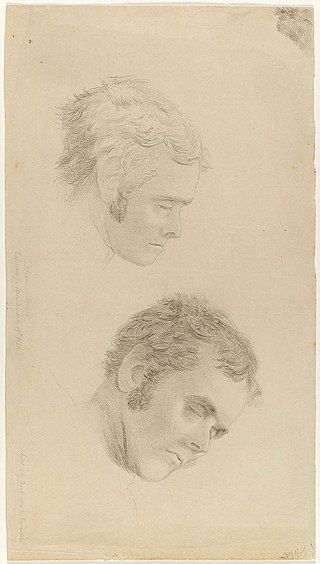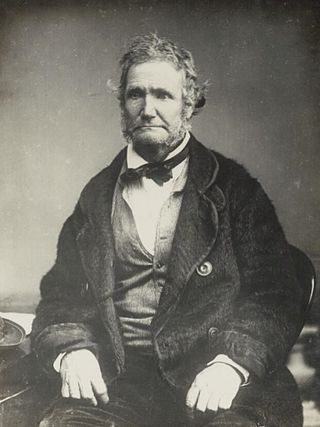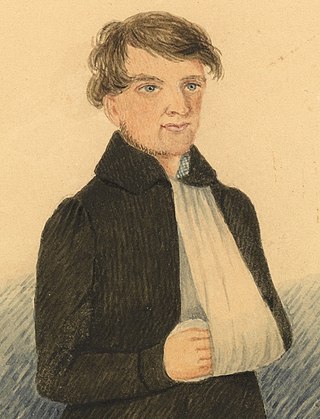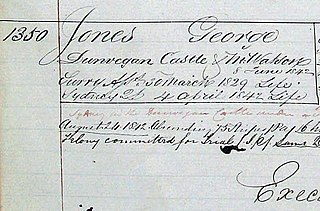
Tasmania is an island state of Australia. It is located 240 kilometres (150 miles) to the south of the Australian mainland, separated from it by the Bass Strait, with the archipelago containing the southernmost point of the country. The state encompasses the main island of Tasmania, the 26th-largest island in the world, and the surrounding 1000 islands. It is Australia's least populous state, with 569,825 residents as of December 2021. The state capital and largest city is Hobart, with around 40 percent of the population living in the Greater Hobart area. This makes it Australia's most decentralised state.

Alexander Pearce was an Irish convict who was transported to the penal colony in Van Diemen's Land, Australia for seven years for theft. He escaped from prison several times, allegedly becoming a cannibal during one of the escapes. In another escape, with one companion, he allegedly killed him and ate him in pieces. He was eventually captured and was hanged in Hobart for murder, before being dissected.

Martin Cash was a notorious Irish-Australian convict bushranger, known for escaping twice from Port Arthur, Van Diemen's Land. His 1870 autobiography, The Adventures of Martin Cash, ghostwritten by James Lester Burke, also a former convict, became a best seller in Australia.

Lawrence Kavenagh was an Irish-Australian convict bushranger who, with Martin Cash and George Jones, escaped from Port Arthur, Van Diemen's Land, in late 1842. The three men took to bushranging for a six-month period, robbing homesteads and inns with seeming impunity. Kavenagh was tried for serious crimes on five separate occasions. He was executed in 1846 at Norfolk Island.

John Helder Wedge was a surveyor, explorer and politician in Van Diemen's Land.

William Sorell was a soldier and third Lieutenant-Governor of Van Diemen's Land.

The Tasmanian emu is an extinct subspecies of emu. It was found in Tasmania, where it had become isolated during the Late Pleistocene. As opposed to the other insular emu taxa, the King Island emu and the Kangaroo Island emu, the population on Tasmania was sizable, meaning that there were no marked effects of small population size as in the other two isolates.

Sir John Eardley Eardley-Wilmot, 1st Baronet was a politician in the United Kingdom who served as Member of Parliament (MP) for North Warwickshire and then as Lieutenant-Governor of Van Diemen's Land.

Benjamin Duterrau was an English painter, etcher, engraver, sculptor and art lecturer who emigrated to Tasmania. There he became known for his images of Indigenous people and Australian history paintings.
John Francis was one of a party of bushrangers who held up the Melbourne Private Escort Company's regular escort of gold from the McIvor diggings at Heathcote, Victoria and Kyneton on the morning of 20 July 1853. At least six men were involved, five of whom including Francis and his brother, George Francis, were apprehended. His brother committed suicide while in custody, but by turning Queen's Evidence, Francis escaped punishment and the other three companions were hanged.

The Royal Society of Tasmania (RST) was formed in 1843. It was the first Royal Society outside the United Kingdom, and its mission is the advancement of knowledge.

Thomas Davey was a New South Wales Marine and member of the First Fleet to New South Wales, who went on to become the second Lieutenant Governor of Van Diemen's Land.
David Burn was a Tasmanian pioneer and dramatist, author of the first Australian drama to be performed on stage, The Bushrangers.
William Humphrys was an engraver of pictures, book illustrations and postage stamps.
Andrew Bent was a printer, publisher and newspaper proprietor, active in Australia. He established the first successful newspaper in Tasmania, was the first Australian newspaperman to print a newspaper free from government control, and the first Australian printer to be imprisoned for libel.
Richard Jarman was an artist, map-maker, and engraver who was active in London prior to 1857 and in Tasmania between 1857 and the 1870s.

George Jones (c. 1815 – 30 April 1844) was a convict bushranger who, with Martin Cash and Lawrence Kavenagh, escaped from Port Arthur, Van Diemen's Land, in late 1842. The three men took to bushranging for a six-month period, robbing homesteads and inns with seeming impunity. After Kavenagh and Cash were captured, Jones remained at large for a further seven months, committing a number of robberies in company with two other escaped convicts. In April 1844 he was captured in a shoot-out with police, convicted and executed.
Crime in Tasmania has existed since the earliest days of the European settlement in 1803. Laws creating criminal offences are contained entirely in statutes, statutory regulations, and by-laws, common law offences having been abolished by the Criminal Code Act 1924 s 6. Most offences are enforced by Tasmania Police, although a small category of offences are prosecuted by other statutory authorities such as local governments, and the Tasmanian branch of RSPCA Australia. All offences are prosecuted through the Tasmanian justice system, and sentences of imprisonment are administered by the Tasmania Prison Service. Some crime statistics for Tasmania are provided on the Tasmania Police website.

Hollow Tree is a rural locality in the local government area of Central Highlands in the Central region of Tasmania. It is located about 17 kilometres (11 mi) north-east of the town of Hamilton and about 16 kilometres (9.9 mi) south-west of the town of Bothwell in one of Tasmania's key pastoral districts. The 2016 census determined a population of 28 for the state suburb of Hollow Tree.

Douglas Thomas Kilburn was an English-born watercolour painter and professional daguerreotypist who operated in Melbourne 1847–49, producing some of the earliest portrait photographs of indigenous Australians















